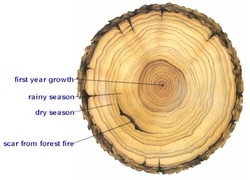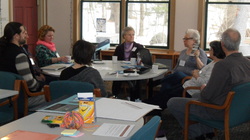In our Resources section, which is password protected but you should have access, we now have a scan of key selections from the book No Citizen Left Behind which is part of our preparation for the April Institute. The .pdf file is one of the first items at the top of our Resources page. I took a paragraph from this book and used it in two different ways with two different classes. With my ESL class on comparative culture at SNHU, I had them respond to it in a PowerPoint presentation. With my College Composition class at MCC, I had them respond to it in an essay for their midterm. Here is the midterm with the paragraph I used:
Answer the question: what is a good citizen? In your answer, respond to the following quote:
Can you be a good citizen if you don’t vote? What if you vote, but are uninformed about most of the issues and candidates, or vote solely on the basis of a single issue? How important is it to be law-abiding? Is being economically self-sufficient a hallmark (or even a precondition) of good citizenship? Is never being a burden on others enough to make one a good citizen? How should we judge the act of protesting injustice via civil disobedience against the act of sacrificing oneself on the battlefield for the good of the country?
From No Citizen Left Behind
by Meira Levinson
I got amazing results from both classes!
I wanted to share an opportunity with you all! I look forward to formally meeting everyone during our April Ins
Here is the link for details about this sustainability institute and application:
Hello All: This is a great program that immerses you in studying Gandhi and his impact on the world. I did it about 5 years ago and loved the two weeks in California. All it cost me was the plane ticket, some walk-around money, and tickets to the Hollywood Bowl. It was an 8 credit graduate course!!! I would highlight the following • Residential Fellowship. Successful participants will be awarded fellowships covering the costs of instruction plus room and board for two weeks, books and materials, and the use of Cal Poly Pomona Library. • Course Credit, Professional Development and Career Advancement. The Fellowship award will also cover the cost of 8 units of course credits. These credits may be used toward a Master’s degree and/or salary advancement. Call for Applications Residential Summer Institute Fellowship for K-12 Educators
Gandhi, Sustainability and Happiness Cal Poly Pomona July 29-August 12, 2013 Application Deadline: Monday, April 8, 2013 Download the Program Flyer Ahimsa Center’s 2013 Summer Institute for K-12 teachers—the fifth one in a series on education about nonviolence—will focus on Mohandas K. Gandhi, Sustainability, and Happiness. Gandhi’s enduring significance is anchored in his uncompromising commitment to ahimsa or nonviolence—the experience of oneness with others and nature--as the foundation for his vision of humanity, and for the well-being and happiness of all, which he called sarvodaya. Sustainability refers to the ability to sustain life, while maintaining an ecological balance that is rooted in caring for nature and caring for the needs of generations to come. Happiness endures in a solidly grounded sense of well-being, of flourishing, and of having found meaning and purpose in life. This two-week residential institute will focus on examining the relevance of Gandhi’s thought for the current discourses on sustainability and happiness. This institute will provide a select group of forty K-12 educators an extraordinary opportunity for educational leadership by becoming adept at integrating in school curricula the lessons based on critical understanding of Gandhi’s life and its significance for achieving the goals of sustainability and enduring happiness. For fellowship details, including selection criteria, and application procedure, visit http://www.csupomona.edu/~ahimsacenter/institute/summer_institute_2013.shtml Applications will be accepted through Monday, April 8, 2013 and will be reviewed as they come in. Early application is strongly recommended. For queries or additional information, please feel free to contact [email protected]Tara Sethia, Ph.D. Director, Ahimsa Center Professor of History Cal Poly Pomona Pomona, CA 91768 (909) 869-3868[email protected]http://www.csupomona.edu/~ahimsacenter/ahimsa_home.shtmlAlso, if you're into LEGOS and have a teacher you can partner with, here's a grant that's due NEXT week.... http://www.edublue.org/Item.asp?art=2
 One item that came up today involved the question of why and how one generation reacts differently from the next generation to stressors (like how Las Madres reacted to the Disappeared Ones versus the orphan daughter astronomer). This made me think about the rings of a tree. If we consider each year of a culture’s development to be represented by a ring of growth in the tree, we can make some comparisons that help wrap our minds around sustainability and its function. A good year’s growth would be one in which all sustaining factors are met: environmental conditions are correct for optimal growth and minimal damage.
One year, an axe scars the outer skin of the tree; here is Pinochet’s terror. The tree weeps; it bleeds sap and begins the process of healing. Subsequent years’ growth in that area is focused on repairing the damage. Those scarred areas don’t transmit nutrient any longer, but the tree repurposed energy to move growth along regardless. If the scar is deep enough, this can take years to heal and the tree’s overall health will suffer.
Another year, on another part of the tree, damage from the strong winds of a hurricane weakens one side of the tree’s infrastructure; the tree responds by developing more root strength and greater toughness tissues to sustain the weight and balance of the tree. Taking a core sample from this tree in one vector may reveal decades of no damage; these are our privileged few. A tree old enough will have hidden scars underneath its layers. Anyone who splits and burns wood will tell you these are strong parts, tougher to split and usually burn better. It is these features of the tree’s growth and its reaction to pain and suffering that make the tree sustainable.
If we compare the tree's system to sustainability in education, then we would be an agent that undertakes the burden of belaying stress, pain, and suffering and buffering it so that the whole impact is spread throughout to alleviate scarring and move growth forward. We may not stop the scarring (and perhaps not directly address the pain, like the young woman raised by grandparents after her parents Disappeared did not immediately go looking for bones) but we all can help repurpose energy to heal and move culture forward, hopefully, and taller. - Amanda Eason
 We began day two of our 2 1/2 day first institute (after a wonderful tour of James Hall and the Scheier displays at Dimond Library on the UNH campus) this morning with participants sharing artifacts they use in their teaching. Teachers and faculty talked about curricula they use, assignments they've given to students, media they use to inspire (like NPR's This I Know), even rocks they've collected from hikes. The diversity of the artifacts was fascinating, but all showed how participants are developing purposeful curricula to engage their students in big issues and topics but in ways that connect to them personally - stories, passport boxes, films, etc. The compassion the participants have for their students is evident.
Questions came out that are tied directly to sustainability: how do we help our students learning to trust, how do we help create a sense of place and community with our students, what stories help connect students to larger issues and questions? These questions are crucial and will lead us into the rest of the day.
Our very first institute is March 1-3, 2013, on the UNH Durham campus, and we are excited to have you on board for this journey.
This blog is for SLC participants to share what they are learning, ask and answer each other's questions, share ideas, and reflect on the entire process of designing sustainability pedagogy, curricula and assessment strategies for their classrooms.
SLC participants: this is YOUR website and YOUR blog! Start writing, start challenging yourself and each other, and we'll take these ideas and questions and use them at future institutes. You can use them as well as you develop your pedagogy, curricula and assessments.
We at the Sustainability Institute at UNH are thrilled to have this opportunity to work with and learn from you. Sustainability is a big idea. It demands collaboration, a transdisciplinary perspective, and many, many hearts and minds working together to make it happen. We thank you for taking the time out of your busy lives to be part of this new project. We know we will learn so much from each of you, building relationships that last well beyond the life of this project and that will push sustainability forward for our students, the next generation of sustainability leaders.
Welcome to our sustainability learning community!
Sara Cleaves, UNHSI
|


 RSS Feed
RSS Feed